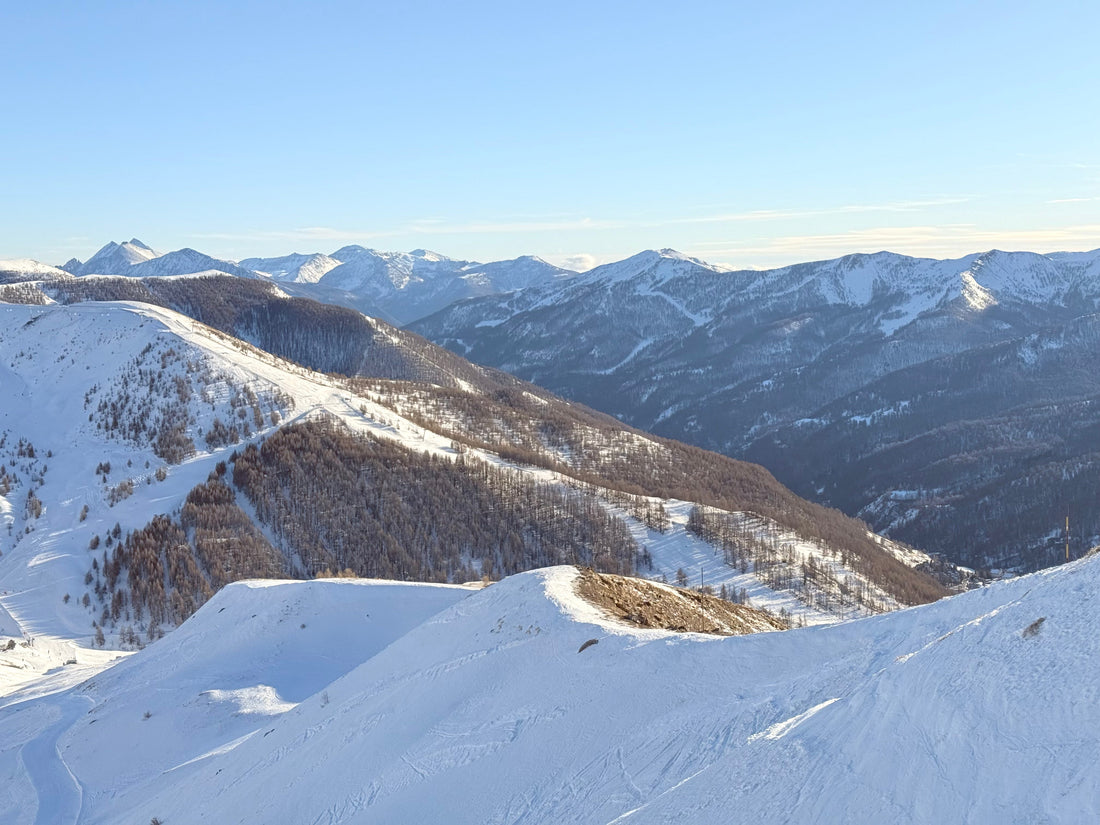The Southern Alps have a rugged charm and snowy peaks, making it the perfect testing ground to gauge early-season fitness and design decisions.
The caterpillar backed up 20 meters to a wider section of the road, letting us squeeze by. As we waved back at the road maintenance worker, disbelief and relief turned into laughter. How, on this nearly empty route through Verdun National Park, did we manage to face a massive road grader just behind the tightest of hairpin turns? This serpentine road, with its endless twists and turns, was anything but boring.
The three-hour drive from Draguignan to Allos felt longer—not from monotony, but from the sheer intensity of the views and the challenge of the road. Approaching the Alps from the southwest is an entirely different experience than from the north. The landscape is dry and rugged, almost desert-like. Then, suddenly, flashes of white high peaks appear on the horizon, signaling the start of winter.
We stopped briefly for espresso and a whole cheese from a local market before continuing to Foux d’Allos. When we finally clipped into our skis, the season officially began. There’s always that fleeting moment of doubt—"Do I still know how to turn these things?"—before muscle memory takes over. The icy slopes and cloudy conditions didn’t make it easy, but after a few laps, the rhythm started to return.
I took the Observatoire lift to 2,600m for a better view of the towering peaks of L’Aiguille own the left and Les 3 Évêchés on the right. The descent was… less impressive. But hey, first turns on the Alps, I will not complain!
A Testing Ground
This trip was also my chance to think about the Adapt-Alpine 25 and its evolution. I brought the original prototype along to see how it felt after the design changes I’d made for the latest version.
The biggest upgrade for the new Adapt-Alpine 25 is the avalanche tool pocket. The original version closed with a flap and adjustable strap, which worked well but expanded inward, reducing space in the main compartment. In the new design, the avi tool pocket is completely external, with a side zipper and a structure that extends outward. It’s faster, easier to access, and doesn’t compete for space with the rest of your gear.
Another big upgrade is the pack’s closure system. The new roll-top design improves water resistance and allows for adjustable volume, while the top strap remains perfect for securing extra gear like a jacket or rope.
Uphill in Allos
The morning after our arrival was clear, and we decided to explore the sunny side of the valley. While the others took the lift, I set off on a touring route up to Col d’Allos and a nearby top station of Marin Pascal chairlift. I unclipped the side straps on my backpack and arranged them for a diagonal ski carry, as the beginning of the route had little snow.
The four straps featured spring hooks on one end and G-hooks on the other, allowing them to be arranged in various ways by attaching them to the external webbing loops. It was a nice idea in theory, but operating the spring hooks in the sunny valley was far easier than it would be in harsher mountain conditions. The new design now features non-detachable straps with a buckle system that’s easier to operate, less likely to get lost, and allows for both A-frame and diagonal ski carry, as well as snowboard carry.
The snow was hard and slippery without ski crampons, and 100 meters from the top, I decided to call it quits. Instead, I cruised down to a gully lined with larch trees and found a cozy lunch spot near a small barn just above a restaurant.
Leaning against the sun-warmed wall with my ski boots off, I munched on a baguette and sipped juice. It was the perfect place to take a break. I could have called it a day, but it was still early, and the summit of Tête de Vescal (2515 m) was calling. It was another 500 vertical meters, but the route was straightforward, and I had time.
I was tired and took short breaks every 15 minutes. On my last rest stop, I sat down to admire the view. I don’t bother carrying extra pads or removing the back panel to sit on—packs should be durable enough to toss in the snow or sit on without worry.
A Reminder
As the sun dipped lower, casting long shadows across the peaks, I strapped on my skis and climbed one last stretch. This season opener was yet another humbling reminder to train a bit more before my next ski touring adventure. I was glad to see how the original Adapt-Alpine 25 held its own—though there was still room for improvement. With each trip and thoughtful iteration, the pack has become more refined, shaped by real-world use and a lot of learning.
My legs were cooked, but I eased into wide arcs across the slope, searching for a bit of energy to push harder on the steeper sections. That’s the thing about ski touring: you spend at least 80% of the day climbing, so you’ve got to learn to love the ascent (and I really do), not just the ride down. It’s the same with designing backpacks and building this business. I enjoy coming up with new ideas, researching materials, connecting with people, and crafting every detail. But at the end of the day, it’s great to make a sale—it’s like that ride down after a long climb.
Pre-orders for the new Adapt-Alpine 25 are now open. Available in Bright Orange and Ghost White, each pack is crafted in small batches. Place your order by February 16 for delivery in March (Week 12).








